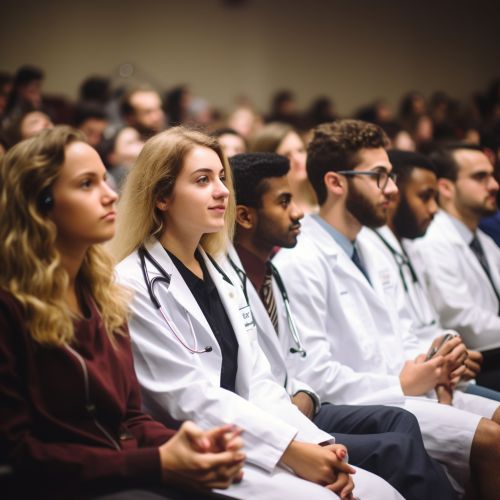Medical education
Introduction
Medical education is the science and practice of educating individuals about medicine. This includes the education of students in medical schools, residency programs, and continuing medical education programs. Medical education also includes the training of allied health professionals, such as nurses and physician assistants.


History
The history of medical education dates back to ancient times. In ancient Greece, the Hippocratic School was one of the first institutions to provide formal medical education. This tradition of medical education continued in the Roman Empire and the Islamic Golden Age, with institutions such as the School of Salerno and the University of Al-Qarawiyyin providing medical education.
In the Middle Ages, medical education was often provided by monastic orders, such as the Benedictines. However, with the rise of universities in the 12th and 13th centuries, medical education began to be provided by these institutions. The first university to establish a medical school was the University of Bologna, followed by the University of Paris and the University of Padua.
The modern system of medical education, with its emphasis on clinical training and scientific research, began in the 19th century. This was largely due to the influence of the Flexner Report, a landmark report that called for the reform of medical education in the United States and Canada.
Types of Medical Education
There are several types of medical education, each designed to train individuals for different roles within the healthcare system.
Undergraduate Medical Education
Undergraduate medical education refers to the education of students in medical schools. This typically involves four years of study, divided into two years of pre-clinical study and two years of clinical study. The pre-clinical years focus on the basic sciences, such as anatomy, physiology, and biochemistry, while the clinical years focus on the diagnosis and treatment of diseases.
Graduate Medical Education
Graduate medical education refers to the education of individuals who have completed medical school and are now training in a specific specialty. This includes residency programs, which provide training in a specific specialty, and fellowship programs, which provide advanced training in a sub-specialty.
Continuing Medical Education
Continuing medical education refers to the ongoing education of healthcare professionals after they have completed their formal training. This includes conferences, workshops, and online courses that provide updates on the latest research and developments in medicine.
Methods of Medical Education
There are several methods used in medical education, each with its own advantages and disadvantages.
Lecture-Based Learning
Lecture-based learning is a traditional method of medical education, in which a teacher presents information to a large group of students. This method is efficient for delivering a large amount of information to a large number of students, but it does not provide opportunities for active learning or individualized instruction.
Problem-Based Learning
Problem-based learning is a more modern method of medical education, in which students learn by solving clinical problems. This method promotes active learning and critical thinking, but it requires a high level of student motivation and self-direction.
Simulation-Based Learning
Simulation-based learning is a method of medical education that uses simulated clinical scenarios to teach students. This method provides a safe environment for students to practice clinical skills and decision-making, but it requires significant resources to implement.
Challenges in Medical Education
There are several challenges in medical education, including the need to keep up with the rapid pace of medical research, the high cost of medical education, and the need to train a diverse healthcare workforce.
Future of Medical Education
The future of medical education is likely to involve a greater emphasis on interprofessional education, in which students from different healthcare professions learn together. There is also likely to be a greater emphasis on technology in medical education, with the use of virtual reality and artificial intelligence becoming more common.
See Also
Medical School Residency (medicine) Continuing Medical Education
